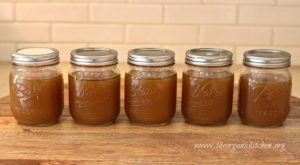I have found bone broth to be the number one thing you can consume for:
- Leaky gut
- Improve joint health
- Boost Immune function
- Overcome allergies and food intolerance’s
Bone broth or stock was a way our ancestors made use of every part of an animal. Bones and marrow, skin and feet, tendons and ligaments that you can’t eat directly, can be boiled then simmered over a period of days. This simmering causes the bones and ligaments to release healing compounds like collagen, proline, glycine, and glutamine that have the power to transform your health.
The Magic of Collagen and Gelatin
Real collagen is the source of stock’s immune-boosting properties. You’ve probably seen this jiggling layer atop the broth in your cooling roasting pan and discarded it but think again next time–this is the good stuff.
Collagen is the protein found in connective tissue of vertebrate animals. It’s abundant in bone, marrow, cartilage, tendons, and ligaments. The breakdown of collagen in bone broths is what produces gelatin.
- Gelatin (the breakdown of collagen) was one of the first functional foods, used as a medical treatment in ancient China.
- Dr. Francis Pottenger and other world class researchers have found gelatin and collagen to have the listed benefits:
- Gelatin helps people with food allergies and sensitivities tolerate those foods including cows milk and gluten.
- Collagen protects and soothes the lining of the digestive tract and can aid in healing IBS, crohn’s, ulcerative colitis and acid reflux.
- Gelatin promotes probiotic balance and growth.
- Bone broth increases collagen reducing the appearance of wrinkles and banishing cellulite.
- Because gelatin helps break down proteins and soothes the gut lining, it may prove useful for leaky gut syndrome and the autoimmune disorders that accompany it.
- Gelatin provides bone-building minerals in easily absorbable ways, preventing bone loss and reducing join pain.3
Healing Amino Acids
Gelatin in bone broths contains “conditional” amino acids arginine, glycine, glutamine and proline. These amino acids also contribute to stock’s healing properties.
Conditional amino acids are those classified as nonessential amino acids that are essential under some conditions: you don’t produce them very well if you are ill or stressed.
What do these conditional amino acids do?
Arginine
- Necessary for immune system function and wound healing
- Needed for the production and release of growth hormone
- Helps regenerate damaged liver cells
- Needed for the production of sperm
Glycine
- Prevents breakdown of protein tissue like muscle
- Used to make bile salts and glutathione
- Helps detoxify the body of chemicals and acts as antioxidant4
- Is a neurotransmitter that improves sleep and improves memory and performance
Proline
- Helps regenerate cartilage and heal joints
- Reduces cellulite and makes skin more supple
- Helps repair leaky gut
Glutamine
- Protects gut lining
- Metabolic fuel for cells in small intestine
- Improves metabolism and muscle building.
*Sally Fallon says that it’s important to use body parts that aren’t commonly found in the meat department of your grocery store, things like chicken feet and neck.
*You’ll also want to buy animal products that you know are pasture-fed and free of antibiotics and hormones.
Cooking Suggestions
- Place roasted bones** into a large stock pot or crock pot.
- Add 1 tablespoons of apple cider vinegar to water prior to cooking. This helps to pull out important nutrients from the bones.
- Fill stock pot with filtered water. Leave plenty of room for water to boil.
- Heat slowly. Bring to a boil and then reduce heat to simmer for at least six hours. Remove scum as it arises.
- Cook slow and at low heat. Chicken bones can cook for 12- 24 hours. Beef bones can cook for 24-48 hours. A low and slow cook time is necessary in order to fully extract the nutrients in and around bone.
- You can also add in vegetables such as onions, garlic, carrots, potatoes, mushrooms, kale, parsley, and celery for added nutrient value.
After cooking, the broth will cool and a layer of fat will harden on top. This layer protects the broth beneath. Discard this layer only when you are about to eat the broth.
** this is optional but adds great flavor
Bone Broth Benefits as Therapy
Remember, bone broth is rich in minerals that support the immune system and contains healing compounds like collagen, glutamine, glycine, and proline.
The collagen in bone broth will heal your gut lining and reduce intestinal inflammation. In addition, collagen will support healthy skin and can reduce the appearance of cellulite. Also, the glycine in bone broth can detoxify your cells from chemicals and improve brain function.
References
Kaayla T. Daniel, “Why Broth is Beautiful: Essential Roles for Proline, Glycine and Gelatin,” Weston A. Price Foundation. http://www.westonaprice.org/food-features/why-broth-is-beautiful (accessed 18 June 2013).
University of Nebraska Medical Center. “Chicken Soup for a Cold” http://www.unmc.edu/publicrelations/chickensoup_newsrelease.htm (accessed 21 October 2011).
Kaayla T. Daniel, “Taking Stock: Soup for Healing Body, Mind, Mood, and Soul,” Psychology Today http://www.psychologytoday.com/blog/naughty-nutrition/201202/taking-stock-soup-healing-body-mind-mood-and-soul (accessed 20 February 2012).
Sekhar RV, Patel SG, Guthikonda AP, Reid M, Balasubramanyam A, Taffet GE, Jahoor F. Deficient synthesis of glutathione underlies oxidative stress in aging and can be corrected by dietary cysteine and glycine supplementation. American Journal of Clinical Nutrition.2011;94(3):847-53
Gersten D, The 20 Amino Acids: What They Are and How They Keep You Alive and Vibrant. http://www.imagerynet.com/amino/20_amino.html (accessed 28 June 2013).

